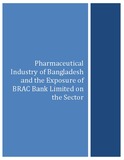| dc.contributor.advisor | Shahbazi, Syeda Shaharbanu | |
| dc.contributor.author | Bristy, Sanjida Nahar | |
| dc.date.accessioned | 2013-05-27T05:22:34Z | |
| dc.date.available | 2013-05-27T05:22:34Z | |
| dc.date.copyright | 2012 | |
| dc.date.issued | 2012-01-09 | |
| dc.identifier.other | ID 09104034 | |
| dc.identifier.uri | http://hdl.handle.net/10361/2480 | |
| dc.description | This internship report is submitted in a partial fulfillment of the requirements for the degree of Bachelor of Business Administration,2012. | |
| dc.description | Cataloged from PDF version of Internship report. | |
| dc.description | Includes bibliographical references (page 42). | |
| dc.description.abstract | I have worked in the Corporate Banking Division of BRAC Bank as a part of the internship program and learned a lot about corporate banking and its operations. The objective of preparing this report is to learn about the pharmaceutical Industry of Bangladesh and the exposure of BRAC Bank on this industry. BRAC is a development organization and was established in 1972 whereasBRAC Bank started its operations in 2001as a commercial venture of BRAC. Though the main focus of the bank is to serve the “missing middle” meaning the SME sector, the performance of Corporate Banking Division is satisfactory and the exposure on different industries is diverse. One of the main focuses of the division is to create a larger client base in the pharmaceutical industry and to maintain relationship with the existing. Pharmaceutical Industry is one of the fastest growing industries in the country with an annual average growth rate of 17.2% over the last five years and 13.1% over the last decade. It is technologically one of the most developed and the third largest industry in terms of contribution to government’s revenue. This industry contributes about 1% of the total GDP.In 2012, Bangladesh was in the 15th position among the 18 markets in the Asia-Pacific region. There are about 250 licensed pharmaceutical manufacturers in the country. However, currently a little over 100 companies are in operation and the top 20 companies hold 85% of the total market share. Bangladesh manufactures about 450 generic drugs for 5,300 registered brands that have 8,300 different forms of dosages and strengths. Two/three decades back imports used to dominate the market, now domestic manufacturers account for 97% of the drug sales in the local market while the remaining 3% are imported. The imported drugs include essential live saving drugs and other high quality drugs. Drug Ordinance Act 1982 and The TRIPS agreement have a huge impact on the overall pharmaceutical industry of Bangladesh. One has restricted the import of products which are already locally manufactured and the latter has given Bangladesh the right to reverse-engineer of any drugs regardless of their patent status. The exports have increased by 16.1% in the year 2011 from the previous year. The government of Bangladesh has provided sufficient regulatory assistance in the overall development of the industry. The industry players need to be aware of their growth prospects as well and should take necessary steps accordingly. | en_US |
| dc.description.statementofresponsibility | Sanjida Nahar Bristy | |
| dc.format.extent | 48 pages | |
| dc.language.iso | en | en_US |
| dc.publisher | BRAC University | en_US |
| dc.rights | BRAC University Internship reports are protected by copyright. They may be viewed from this source for any purpose, but reproduction or distribution in any format is prohibited without written permission. | |
| dc.subject | Business administration | |
| dc.title | Pharmaceutical industry of Bangladesh and the exposure of BRAC Bank Limited on the sector | en_US |
| dc.type | Internship report | en_US |
| dc.contributor.department | BRAC Business School, BRAC University | |
| dc.description.degree | B. Business Administration | |

